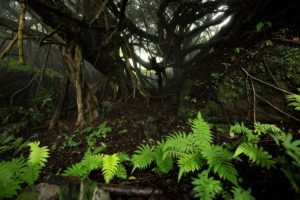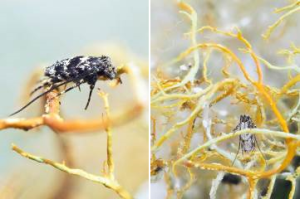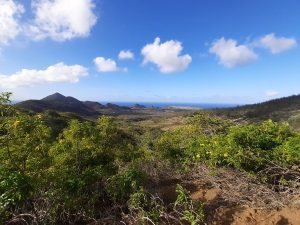
Photo by Matt Wall
Ascension Island’s cloud forest zone, or mist region, is confined to the summit slopes of Green Mountain. The area is frequently enveloped by cloud banks, resulting in perpetually damp conditions. Although the ecosystem shares many of the features of a true cloud forest, the original vegetation of this zone was treeless and dominated by ferns and bryophytes, including several endemic species.
Most of these native habitats have been replaced by a novel ecosystem of introduced species like yellow boy, guava, ginger and bambooHowever, isolated pockets of native vegetation still survive on the most exposed slopes and outcrops. The mist region remains the centre of botanical diversity within the Territory, supporting populations of 15 out of the 18 known endemic plant species , such as purple fern (Ptisana purpurascens), hedgehog grass (Sporobolus caespitosus) and moss fern, (Stenogrammatis ascensionensis). The native fauna is composed of a limited number of invertebrate species, vastly outnumbered by introduced counterparts. One unique resident of this ecosystem is the endemic moth, Gray’s fungus moth (Erechthias grayi), This moth has evolved smaller wings so that it does not get blown away off Green Mountain and has evolved to hop instead of fly.

Photo by Adam Sharp
The montane mist region is Ascension Island’s most restricted bioclimatic zone, confined to an area of less than 1 square kilometre. This region encompasses the summit ridge and uppermost slopes of Green Mountain. Due to the lack of detailed habitat mapping and climatic data, an elevation range between 660 and 870 meters is generally used to describe the mist-affected area. However, it’s important to note that the prevailing south-easterly trade winds likely create some variations in conditions between the windward and leeward slopes.
Invasive species posethe most immediate threat to the ecological integrity of the mist zone; these introduced species have already smothered large tracts of prime native habitat. The impact extends to Green Mountain National Park, where invasive growth obstructs footpaths and hinders panoramic views of the Island.

Photo by Vicky Knight
Climate change presents a potentially significant, but unpredictable, long-term threat. Global trends suggest rising temperatures and reduced low-level cloud cover could displacemany high-altitude cloud forests. In the case of Ascension Island, even a minor increase in the altitude where clouds form could mean that Green Mountain would lack its characteristic mist region for a significant part of the year. This would fundamentally alter both the hydrology and ecology of this unique montane ecosystem.
Preserving this rare and delicate bioclimatic zone remains a high-priority conservation goal for Ascension Island, especially in the face of immediate invasive threats and the longer-term uncertainties posed by climate change.
Conservation and Fisheries Directorate
11 September 2023